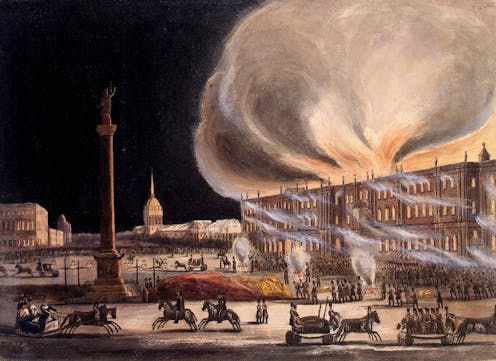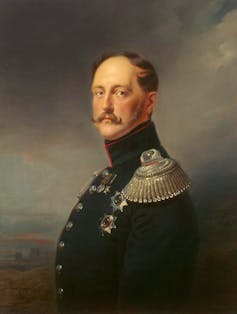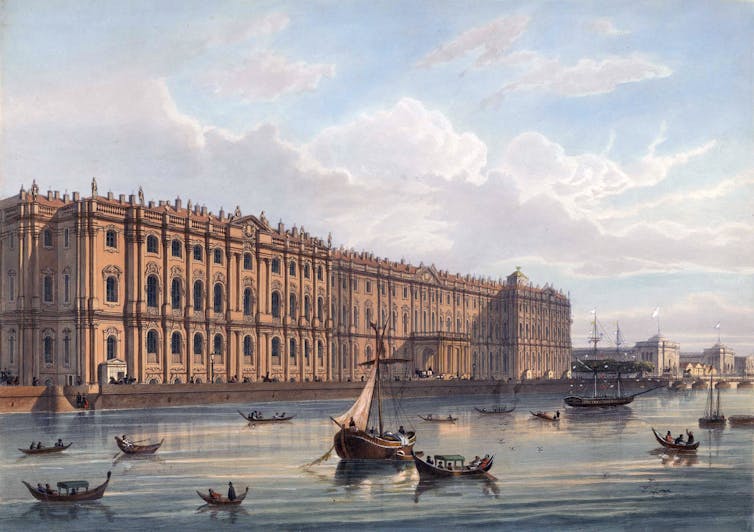In Notre Dame fire, echoes of the 1837 blaze that destroyed Russia's Winter Palace
After the building that symbolized 'all that is Russian' went up in flames, the czar scrambled to restore it to its former glory.

In a city graced with remarkable architecture, the cathedral of Notre Dame may be Paris’ most striking edifice. So when it was engulfed by a fire that toppled its spire, it seemed as if more than a building had been scorched; the nation had lost a piece of its soul.
How can a country respond to witnessing the devastation of its most magnificent structure?
As I watched the images, I couldn’t help but think of a similar tragedy that took place in 19th-century Russia – a story I tell in a forthcoming book about how the year 1837 played a pivotal role in Russian history.
Like the people of France who are mourning the damage to Notre Dame, the Russians were rocked by the destruction of an iconic building. Their rebuilding effort might offer some inspiration for a French populace looking to pick up the pieces of their beloved cathedral.
A palace that symbolizes ‘all that is Russian’
On Dec. 17, 1837, a fire broke out at the Winter Palace in St. Petersburg. Now the site of the famous State Hermitage Museum, back then it served as the primary residence of the czar and his family.
Standing in the heart of the Russian capital, with 60,000 square meters of floor space and 1,500 rooms, the Winter Palace was among the world’s grandest buildings. The Russian poet Vasilii Zhukovskii wrote that the palace was “the representation of all that is Russian, all that is ours, all that relates to the Fatherland.”
Originally completed in 1762, the palace had undergone a renovation just prior to the fire. Historians aren’t precisely sure how the fire started, but they do know that defects from the renovation allowed the flames to spread quickly through the palace’s attics. By evening the structure was completely ablaze, a spectacle visible from miles away.
Informed of the fire while at St. Petersburg’s Bolshoi Theatre, Czar Nicholas I rushed to the palace, only to learn that the building couldn’t be saved. The best the monarch and his personnel could do was salvage prized possessions and prevent the fire’s spread to the Hermitage, where the emperor’s art collection was housed.
By the morning of Dec. 19, only the structure’s skeleton remained and an unknown number of people had died. The ruined palace “stood sullenly like a warrior,” one witness observed, “powerful but covered with wounds and blackened by the smoke of unprecedented battle.”
“The northern capital has lost her greatest ornament,” a local newspaper lamented.
A blow to the ruling regime
For the czar and his regime, the fire presented a political challenge.
The palace – a symbol of autocratic monarchy in an age of revolution – was now in ruins. Might the swift destruction of the palace reflect the fragility of the czarist order?

As with Paris in 2019, people expressed disbelief. How was it possible that this magnificent edifice, this national symbol, could be consigned to such destruction? Nicholas himself fell into depression, haunted by even the whiff of smoke. There were murmurs that the conflagration was God’s punishment for the impieties of a secularizing age.
Fearing that Russia’s detractors would cast the fire as a blow to the regime’s clout, Nicholas’ allies quickly mobilized to shape the narrative in Russia and abroad. They wanted the country to appear united. And they certainly didn’t want despondency to become the story.
Shaped by these imperatives and especially concerns about the international response, the first full account of the fire was written in French by the poet Petr Viazemskii and published in Paris. A Russian translation appeared two months later.
That text and others painted a highly idealized picture of the response to the tragedy. The accounts noted that the emperor forcefully directed the fire’s containment, submitting finally and humbly to God’s will. The empress Alexandra exhibited pious fortitude. Soldiers were selfless in their fervor to save the imperial family’s possessions. The Russian people, viewing the palace as their “national patrimony,” felt the loss just as keenly as the czar. (An assault on his wine cellar, and the disappearance of 215 bottles, was glossed over.)
‘Zeal overcomes all’
To reverse the humiliation of the blaze, Nicholas set a nearly impossible goal: rebuild the palace within 15 months. And to erase any memory of the conflagration, he ordered that the restored palace look exactly as it had before.
Thousands of workers labored on an enormous construction site, blowing hot air from immense furnaces to speed the drying of interiors. Occasionally spurred by sips of vodka, they made rapid progress.
On the fire’s first anniversary, portions of the restored palace were illuminated from within to showcase the progress. And on Easter Night, March 25, 1839, Nicholas celebrated the resurrection not only of Jesus Christ, but of the Winter Palace.
Some 200,000 people visited the building that Easter Day, and 6,000 laborers received a medal inscribed with the words “Zeal overcomes all.”
Outwardly identical to the old version, the new palace featured more iron, brick and ceramic in its structures – and less wood. It now had central heating and running water. It was far less fire-prone than the original.

1837 and 2019
From what we know so far, Notre Dame hasn’t experienced the same level of destruction as the Winter Palace. Mercifully, nobody died. Nor has the blaze of 2019 produced the loss of culture sustained in last year’s fire at Brazil’s National Museum.
Still, the scope of the damage has been vast.
Only time will tell what’s in store for the cathedral. The challenges of reconstruction are great. But like Nicholas, French President Emmanuel Macron has promised swift repairs. Millions in donations have already poured in.
And if the Russian phoenix of 1839 is any indication, there is hope that a renewed Notre Dame will once again grace the banks of the Seine.
Paul W. Werth does not work for, consult, own shares in or receive funding from any company or organisation that would benefit from this article, and has disclosed no relevant affiliations beyond their academic appointment.
Read These Next
The Bible says little about Jesus’ childhood – but that didn’t stop medieval Christians from enjoyin
Legends about Jesus’ early years that circulated in medieval Europe often drew on apocryphal texts.
How a niche Catholic approach to infertility treatment became a new talking point for MAHA conservat
Mainstream medical organizations have criticized ‘restorative reproductive medicine,’ but some Catholics…
Black-market oil buyers will push Venezuela for bigger discounts following US seizure – starving Mad
Venezuela relies on the black-market oil trade for a large chunk of its revenue. US enforcement actions…






